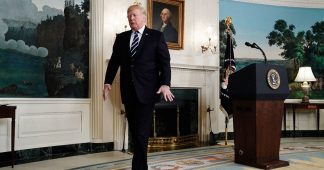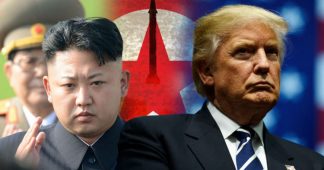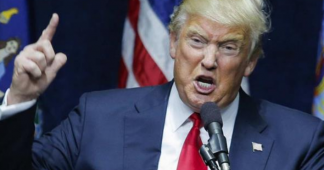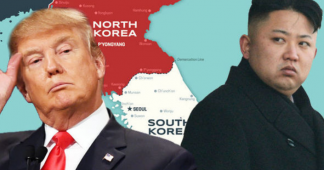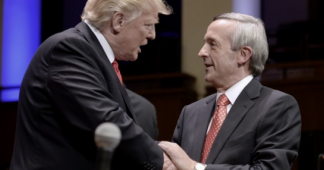ByJoseph Kishore
13 October 2017
Washington is engulfed in a political crisis that is without precedent in modern American history. Amidst increasingly bitter factional conflicts at the highest level of the state, there is growing speculation that there have been secret discussions among cabinet members and high-level staff about forcing Trump out of office.
The political warfare within the Trump administration and Republican Party intensified this week after Senator Bob Corker, the Senate Foreign Relations Committee chairman, declared that Trump’s threats against North Korea were leading the United States “on the path of World War III.” In a Twitter post, Corker called the White House “an adult day care center,” with the president requiring constant supervision.
NBC reported that Secretary of State Rex Tillerson’s statement describing Trump as a “moron” came after a June meeting between the president and top military officials, during which the president advocated increasing the US nuclear arsenal ten-fold. Trump responded to this report by threatening that NBC should be shut down. He stated that it is “disgusting the way the press is able to write whatever they want to write.”
In Vanity Fair on Wednesday, Gabriel Sherman wrote that “a half dozen prominent Republicans and Trump advisers… all describe a White House in crisis as advisers struggle to contain a president that seems to be increasingly unfocused and consumed by dark moods.” Trump allegedly told his longtime security chief, Keith Schiller: “I hate everyone in the White House! There are a few exceptions, but I hate them!”
Sherman indicates that high-level White House personnel are worried that Trump might respond to internal difficulties by exercising his unilateral authority to launch nuclear weapons against North Korea. “One former official even speculated that [White House Chief of Staff John] Kelly and Secretary of Defense James Mattis have discussed what they would do in the event Trump ordered a nuclear first strike. ‘Would they tackle him?’ the person said.”
Several columnists, likely channeling internal discussion, openly raised the possibility of removing Trump using the 25th Amendment—which stipulates that the president may be forced out through a majority vote of his cabinet if he is mentally or physically incapacitated, thus rendering him “unable to discharge the powers and duties of his office.”
Jennifer Rubin, who produces the conservative “Right Turn” for the Washington Post, asked in the headline of her latest column, “When do we reach 25th Amendment territory?” Soon, she concluded. Paul Waldman, in another Post article published Wednesday, declared: “Impeachment probably won’t save us from Trump. But the 25th Amendment might.” Both columns followed the Post’s own editorial, “What to do with an unfit president,” which raised the possibility of impeachment.
Behind these conflicts are deep divisions within the ruling class over critical issues relating to both international and domestic policies. In particular, Trump’s reckless threats against North Korea have unnerved substantial sections of the State Department and the Pentagon. A war with Korea could result in the destruction of millions of lives and lead to a direct confrontation with China and Russia, sparking—as Corker put it—World War III. But even worse than the loss of lives, as far as Trump’s opponents are concerned, would be the irreparable damage that a war would cause to the international standing of the United States.
Whatever the motives underlying behind-the-scenes discussions of the feasibility of a palace coup, such a conspiracy—regardless of its success or failure—would drive the final nail into the coffin of American democracy.
Trump would undoubtedly bitterly resist an effort to remove him from office. In the course of a ferocious conflict, both pro- and anti-Trump factions would appeal to the military and intelligence agencies for support. Regardless of which faction won, the military and intelligence agencies would emerge as the final arbiters of the political destiny of the United States. Moreover, were Trump to be removed from office, the arch-reactionary vice president, Mike Pence, would become president.
For their part, the Democrats have responded to the crisis by escalating their neo-McCarthyite campaign over Russian intervention in US politics, which is increasingly focused not only on manufactured charges that Russia aided the election of Trump, but that Moscow is “sowing divisions” within the United States. Arguments are being developed to justify imposing censorship and state control over the Internet, and to blackguard all social and political opposition as a product of the nefarious intervention of a “foreign enemy.”
As the WSWS warned in June, the methods of Trump’s ruling-class opponents “are fundamentally anti-democratic, involving behind-the-scenes plotting with elements within the military/intelligence establishment and corporate-financial elite.”
Trump’s ruling class critics are desperately seeking some way to respond to an array of global geopolitical, economic, military and social crises for which they have no solution. Trump is not the cause, but rather an extreme symptom of the disorientation and desperation of the ruling class.
Nothing can be more dangerous than to leave the resolution of the crisis to these rival camps of the ruling elite. All factions of the ruling oligarchy, however bitter their differences, are determined to prevent the emergence of the working class as an independent force. They want to resolve the crisis in a way that does not hurt their global interests or weaken their grip on power.
This state of affairs cannot last. The crisis of class rule has as its necessary corollary the growth of the class struggle. As the Socialist Equality Party wrote in its June statement, “Palace coup or class struggle: The political crisis in Washington and the strategy of the working class”:
The interaction of objective conditions of crisis, both within the United States and internationally, and the radicalization of mass social consciousness will find expression in the eruption of class struggle. The decades-long suppression of the class struggle by the trade union bureaucracy, the Democratic Party and the affluent sponsors of various forms of identity politics is coming to an end. The social counterrevolution of the ruling elites is about to encounter an upsurge of the American working class. The many different forms of social protest—in work places, communities and entire cities—will acquire an ever more distinct working class identity, anti-capitalist orientation and socialistic character. Struggles in individual work places and communities will draw into unified struggle broader sections of the working class.
The critical question is to impart to this movement of the working class a consciousness of its aims, to build a political leadership that can guide these struggles, in the United States and internationally, to their logical and necessary end: the overthrow of the capitalist system and the establishment of socialism.
